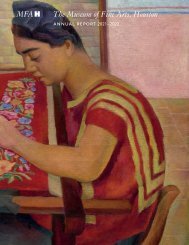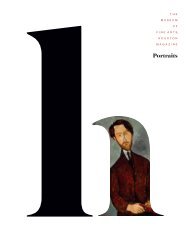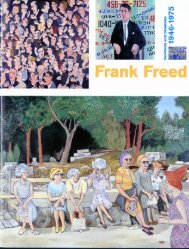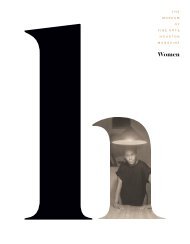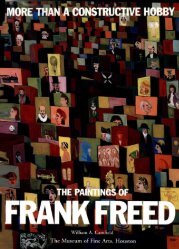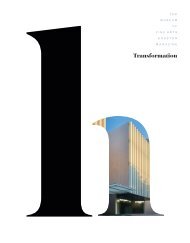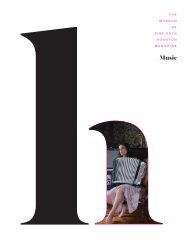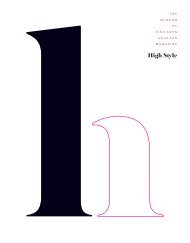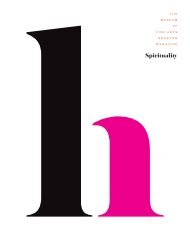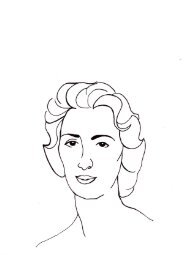Create successful ePaper yourself
Turn your PDF publications into a flip-book with our unique Google optimized e-Paper software.
Le cabinet du psy (2005) immerses the viewer in a<br />
psychoanalyst’s office. Can you talk about your interest<br />
in psychoanalysis, how it developed, and how it informs<br />
your work?<br />
As someone who grew up in Buenos Aires, which has one of<br />
the highest concentrations of psychoanalysts in the world,<br />
it’s unavoidable. Our daily discourse is full of the language of<br />
psychoanalysis, as are people’s daily lives. French structuralists<br />
have also been very important for Argentine intellectuals, so we<br />
are always on the divan in one way or another. My work is often<br />
associated with the Freudian concept of the uncanny, which<br />
is certainly present in this piece, where we are “neither here<br />
nor there,” where the ordinary has become suddenly and<br />
mysteriously strange.<br />
Does a variation of voyeurism—or a kind of autovoyeurism,<br />
if you will—play a role in Le cabinet du psy?<br />
At first glance, viewers seem to be offered an opportunity<br />
to peek in on a private space, one where theoretically<br />
the unconscious will also be on “display” through the<br />
process of psychoanalysis, which could add another level<br />
of intimacy to the revelation; however, instead of looking<br />
upon the bodies and psyches of others, viewers are<br />
ultimately “spying” on themselves.<br />
First off, there are certain spaces that have a kind of charge,<br />
and the psychoanalyst’s office is one of them; it’s a very private<br />
place, a kind of inner sanctum. <strong>The</strong>re is a thrill to this private<br />
view, but we end up looking at our own projected images,<br />
though we are only half there, like ghosts. This is where my<br />
interest really lies, the moment when we know where we are<br />
physically, and yet we seem to be somewhere else. <strong>The</strong> mind<br />
understands the process, and yet it’s very confusing. Not<br />
unlike the kind of projection we experience in our relationships<br />
with other people—and with ourselves.<br />
You often use mirrors and glass to play with perception, to<br />
create illusions, and to destabilize. In Le cabinet du psy, the<br />
glass and mirrors may even facilitate a temporary feeling<br />
of disembodiedness, where viewers see themselves in<br />
one space but physically feel themselves in another.<br />
When and why did you first start using mirrors and glass<br />
in your work, and how has your understanding of these<br />
materials transformed over the years?<br />
Reflection—or the absence thereof—has always been an<br />
important tool for me. One of my first installations was El<br />
Living (Living Room) (1998), which uses both mirrors and<br />
a duplicate space to play with the expectations baked into<br />
our perception. What you mention here is a key interest<br />
of mine: What happens when we know something to be true<br />
(mirrors reflect our image, boats float in water, walls are solid),<br />
but our experience tells us something else? In that moment of<br />
confusion, the world becomes new again and the ordinary is<br />
suddenly a mystery.<br />
In Bâtiment (2004), which will also be on display at the<br />
Museum, you similarly use mirrors, this time to achieve<br />
the gravity-defying illusion that viewers are hanging<br />
off the elevation of a four-story building. Can you talk<br />
about the role that the feeling of destabilization—<br />
both visual and physical—plays in this work and in your<br />
practice in general?<br />
We believe, in general, that we are on the receiving end of<br />
experience. <strong>The</strong> world is a certain way, and we interact with<br />
that certainty. An installation like Bâtiment changes the rules<br />
and allows us to happen to the world. We are no longer on the<br />
receiving end. This experience has an obviously playful quality,<br />
but I’m very interested in the spectator as co-creator—not<br />
to mention the role that smartphone cameras play in the<br />
reproduction of my work, something that I never considered<br />
but that has become a creative force. I was amazed when<br />
I discovered what was happening with my work on Instagram,<br />
for example, and how far people have gone with their own<br />
creativity—which is really gratifying. But none of that would<br />
happen without that moment of destabilization or confusion<br />
or surprise. Reality opens up, suddenly, and we jump in.<br />
Tell us a little about the issues and themes that are occupying<br />
your thoughts currently. What can we expect from<br />
Leandro Erlich next?<br />
I have become increasingly focused on our relationship to the<br />
earth, thinking about the human imprint of the Anthropocene<br />
and the way we distinguish between “organic” and “artificial” in<br />
a way not unlike our distinction between “real” and “imaginary.”<br />
Recent works like Order of Importance (2019) and Concrete<br />
Coral (2021–22) address our impact on the planet as creators<br />
in a world that bears our stamp. I also have an upcoming<br />
retrospective at the Pérez Art Museum Miami (PAMM). It’s<br />
very significant for me to show my work again in Houston, a<br />
place that was seminal for me as an artist and has made so<br />
many things possible.<br />
45




